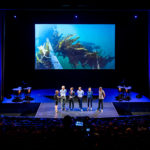The 2015 Washington Ideas Forum — presented by The Atlantic magazine and the Aspen Institute on Wednesday, Sept. 30–Thursday, Oct. 1 — was an interesting and lively event, and maybe the most impressive thing about it was how smartly it translated The Atlantic‘s print-based editorial perspective into a live program.
Held at Harman Hall, in the Harman Center for the Arts in downtown Washington, D.C., the Forum offered a fast-paced, sometimes dizzying mashup of content — along with a blueprint for organizations that have access to content and experts they might incorporate into their meetings and conferences. Here are five suggestions based on what I saw at the Forum along with a quick on-site interview with Margaret Low Smith, president of AtlanticLIVE, The Atlantic‘s events division:
1. Make it multidisciplinary. The Atlantic covers politics, science, culture, business, and anything else that interests its editors, and that omnivorous sensibility informed the entire Forum program. One 90-minute block on Wednesday morning included Atlantic contributor Amanda Ripley offering a lighthearted look at drones based on her upcoming article in the November issue of the magazine; two meaty, D.C.-flavored interviews — The Atlantic’s Ronald Brownstein talking to U.S. Commerce Secretary Penny Pritzker, and Aspen Institute President Walter Isaacson talking to Colin Powell; a gripping sitdown between Atlantic President and Editor in Chief James Bennet and Theo Padnos, an American journalist who was held captive and tortured in Syria for nearly two years, and two members of Padnos’ family; and more.
The result was an intellectual and emotional mix that engaged hearts and minds alike. Associations and other meeting organizers might not have the topical latitude to paint on such a broad canvas — but that doesn’t mean you can’t add some brushstrokes from outside your industry.

2. Shake up your pacing. Ripley talked for 10 minutes, the Pritzker and Powell interviews were 15 and 20 minutes, respectively, and the Padnos conversation lasted 25 minutes, the longest slot of the day. Even Mitt Romney only got only 20 minutes. The pacing helped keep the program focused on one or two main takeaways per speaker.
Smith aimed to complement not just the goals of the Forum but the dynamics of Harman Hall — a performing-arts theater with two levels of tiered seating. “There’s a special intimacy that happens in a space like this, where it’s a beautiful stage,” Smith said. “People have dedicated a morning, or a day and a half. They’re actually willing to listen in a very different way. There’s something in this relentless, multitasking world of ours about stopping and listening to somebody for 20 minutes that I think makes people think in a different way, in a very special way.”

3. Use your assets … Many of the Forum’s presenters and interviewers were Atlantic editors and writers — people who are used to asking questions and analyzing answers, and writing about complex issues in a way that makes sense to a mass audience. “Part of what is so meaningful is just to be associated with the journalism of The Atlantic,” Smith said, which “does take time to reflect and dig deep and also to be bold and provocative at the same time.”
4. … but don’t lean on them like a crutch. Smith and her team also had to respect that, as a live event, the Forum was its own living, breathing entity. “You want the essential qualities to have the same DNA as what’s in the magazine and what’s online, yet every platform has its own essence,” Smith said. “Everything we do, whether it’s the magazine or what we do online or live, is really about the experience. [The Forum is] different because it’s live and it requires a whole sphere of activity that the magazine doesn’t require and vice versa.”

5. Turn your sponsors into content — and skip the sales pitches. The Forum had three “presenting underwriters”: Hitachi, Comcast NBCUniversal, and aetnahealth. Each of them spent time onstage on Wednesday — but rather than doing a straight-up sales pitch, Comcast Senior Executive Vice President David L. Cohen talked with MSNBC’s José Díaz-Balart about bridging the Digital Divide, while Hitachi President and CEO Mike Tanner offered a five-minute “executive perspective” on challenges facing society. And aetnahealth founder and CEO Jonathan Bush was actually part of the editorial program — contacted by the Forum’s editorial-content team — sitting for an interview with financial journalist Felix Salmon about the need for a health-care revolution. In other words, as advertorial and editorial, all three became part of the conversation. “You want people to be actually more thoughtful, contemplative, say things that you might not expect them to say,” Smith said. “Ask them questions that nobody has asked them before.”




